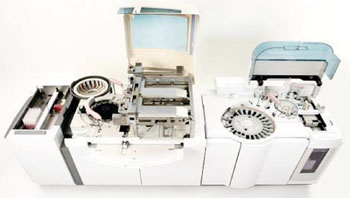Low Density Lipoprotein Apolipoprotein-B Assay Validated
By LabMedica International staff writers
Posted on 20 Nov 2014
The relationship between apolipoprotein-B (Apo-B) concentration and the risk of developing cardiovascular disease (CVD) is more robust than the relationship between low density lipoprotein cholesterol (LDL-C) concentration and CVD.Posted on 20 Nov 2014
It is however unknown if Apo-B or low density lipoprotein (LDL) particle number (LDL-P) has a stronger predictive ability for future CHD and this uncertainty may be due to the inability of current Apo-B assays to separate the contribution of very low-density lipoprotein particles (VLDL-P) from the total Apo-B concentration.

Image: The Cobas 6000 Multipurpose Clinical Laboratory analyzer (Photo courtesy of Roche Diagnostics).
Scientists at the Dartmouth-Hitchcock Medical Center (Lebanon, NH, USA) obtained a total of 300 lithium heparinized patient plasma samples submitted for routine fasting lipid profile. The profile included total cholesterol, high density lipoprotein (HDL), triglycerides and calculated LDL cholesterol and was included for analysis via both the LDL Apo-B assay as well as a Direct LDL assay on a specific immunoassay analyzer.
The LDL Apo-B assay (Maine Standards Company; Windham, ME, USA) for use on the Roche Cobas 6000 analyzer (Indianapolis, IN, USA) is an immunoturbidometric assay employing a polyclonal antiserum against Apo-B. In order to accurately quantify only the Apo-B content on LDL particles, the patient samples are first automatically diluted via the instrument. The collaborating scientists at Maine Standards developed an automated immunoturbidimetric assay for the Cobas 6000 analyzer that specifically quantifies the Apo-B present on the surface of LDL particles.
The LDL Apo-B within-run imprecision was 2.3% at 62 mg/dL and 2.2% at 109 mg/dL. The within-laboratory imprecision was 9.7% at 57 mg/dl and 6.1% at 104 mg/dL. There was no strong linear relationship between the calculated or measured LDL cholesterol concentration and the measured LDL Apo-B concentration. The assay demonstrated laboratory acceptable precision, low limit of quantitation (LoQ) and a wide measurement range. This assay that specifically measures Apo-B on LDL particles demonstrated a positive correlation with LDL-C that is not unlike the relationship between LDL-C and total Apo-B.
The authors concluded that they had verified the relationship between the LDL Apo-B concentration and the LDL-particle assay. This precise and easy to use automated turbidimetric assay for use on the Roche Cobas 6000 analyzer may serve as either a low cost alternative to the high-complexity LDL-particle assay by nuclear magnetic resonance (NMR), or as a screen to identify which patients should have a follow up LDL-particle assessment performed in a reference laboratory. The study was published in the November 2014 issue of the journal Clinical Biochemistry.
Related Links:
Dartmouth-Hitchcock Medical Center
Maine Standards Company
Roche













